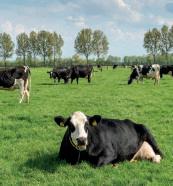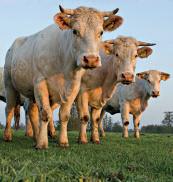Confusion over diagnosing Lactococcus spp. as the cause of mastitis
In the second quarter of 2024, veterinary practices regularly approached the Veekijker and the Udder Health team (UGA), stating Lactococcus spp. as the diagnosis for mastitis more frequently than in the past. This signal is not backed up by studies at GD into the causative agents of mastitis: once again this quarter, Lactococcus spp. represents less than 1 per cent of the causative agents for mastitis. Lactococcus spp. are Gram-positive cocci that – along with Enterococcus spp. and Aerococcus spp. – are classified in the group ‘other streptococci’ (environmental streptococci and streptococcus-like
bacteria). Lactococcus spp. are difficult to distinguish from Streptococcus uberis using classical detection methods (such as biochemical testing). Veterinary practices stated that they had diagnosed Lactococcus spp. as the cause of mastitis and differentiated it from Streptococcus uberis on the basis of an antibiogram carried out at the practice. Streptococcus spp. are intrinsically resistant to aminoglycosides such as e.g. neomycin and kanamycin. Streptococcus spp. typically have small inhibition zone diameters in an antibiogram based on agar diffusion with paper discs (as
widely used in practice). Lactococcus spp. mostly have larger inhibition zone diameters for aminoglycosides than Streptococcus species. This identification is however not conclusive because the values of the inhibition zones of Lactococcus spp. can overlap with those of Streptococcus spp. Only molecular tests such as PCR, whole-genome sequence analysis and MALDI-TOF MS are suitable for definitive identification.
Severe effects of suspected poisoning with ragwort and/or aflatoxins
At the end of the first quarter, a veterinarian approached the Veekijker with a case that continued through to the second quarter. Several heifers at a cattle farm died during a short period some six months ago at the farm’s young cattle site. The hypothesis at the time was that common ragwort may have been present in the hay that was fed to them. Subsequently, several older heifers at various lactation stages died at the dairy cattle site. These heifers were from the same group as the ones that had become ill or died at the earlier stage. The sick animals’ production levels and cud-chewing went down over several days, after which they finally died. Despite the absence of specific disease symptoms, their appetites were greatly reduced and they only wanted to eat hay. Shortly before they died, all the older heifers exhibited the same clinical picture of a central nervous system disorder as the younger ones that had died: lying down, groaning, stamping their feet, symptoms of shock and several cases of rectal prolapse. Similar issues were not observed among the other dairy cows and the other young cattle. At the moment the problems appeared, they were being fed lower-quality green silage in which a few mould spots were visible. Because of suspicions that this silage was playing a role in the issues, the practice
expert advised the livestock farmer to remove the silage and replace it with better-quality silage. One heifer was also submitted for necropsy. The Veekijker veterinarian also advised carrying out blood tests on a few sick heifers from both age groups, for general screening (hepatic values) and investigation of vitamin and mineral levels. This was followed by advice to test the silage for mycotoxins and to have a necropsy carried out if another animal died.
A total of two animals were submitted for pathological examination. Both had a firm liver with extensive fibrosis. This clinical picture is seen in chronic intoxication with pyrrolizidine alkaloids (PA), such as those present in ragwort, and/or intoxication with aflatoxins. Distinguishing between these causes was not possible based on the histological picture. A high copper level was also found in the first animal. Hepatic encephalopathy was observed in the brain, explaining the clinical picture of a central nervous system disorder shortly before death. The GD toxicologist stated that detecting aflatoxins in the animal’s tissues is not something that can be routinely tested. The presence of both aflatoxins and common ragwort in the feed can be demonstrated. It was unfortunately no longer possible to test for mycotoxins or ragwort in the silage that
was fed, given that the livestock farmer had removed the silage on advice from his veterinarian. Given the problems with the younger heifers last year and the older ones from the same group this quarter, it is suspected that this batch of animals had already suffered liver damage (from PA in the hay fed to them) and that they are now more susceptible, as older heifers, to mycotoxins, high copper concentrations in the feed or re-exposure to PA. Given that this hypothesis could mean that the remaining animals from the same batch might also have liver damage, the Veekijker veterinarian recommended testing more animals through a blood test of the hepatic parameters. Various animals did indeed have abnormal liver values to a greater or lesser extent. In the end, the livestock farmer lost 75 per cent of the animals from this group. There were further deaths in the months after the initial contact with the Veekijker as well. The livers of some dead animals were submitted; these showed a picture of severe chronic liver damage with extensive fibrosis, possibly caused by aflatoxins or pyrrozolidine alkaloids. The insurance company was brought in to reimburse the animals lost.
Health of cattle in the Netherlands, second quarter of 2024
VETERINARY DISEASES
Implementing Regulation (EU) 2018/1882 of Animal Health Regulation (AHR) 2016/429 (category A disease)
Lumpy Skin Disease (LSD) Viral infection. The Netherlands is officially disease-free.
Foot and Mouth Disease (FMD) Viral infection. The Netherlands has been officially disease-free since 2001.
A, D, E No infections ever detected.
A, D, E No infections detected.
Implementing Regulation (EU) 2018/1882 of Animal Health Regulation (AHR) 2016/429 (categories B to E)
Bluetongue (BT)
Bovine genital campylobacteriosis
Bluetongue serotype 3 (BTV-3) outbreak in the Netherlands since September 2023.
Bacterium.
The Netherlands has been disease-free since 2009. Monitoring of AI and embryo stations and of animals for export.
Bovine Viral Diarrhoea (BVD) Viral infection.
Control measures compulsory for dairy farms but voluntary on beef cattle farms.
C, D, E Three infections notified. Vaccines are available in the Netherlands. About 23 per cent of dairy cows have antibodies to BTV-3 after the 2023 outbreak.
D, E Campylobacter fetus spp. Veneralis not detected.
C, D, E
Brucellosis (zoonosis, infection through animal contact or inadequately prepared food)
Bacterium.
The Netherlands has been officially diseasefree since 1999. Monitoring via antibody testing of blood samples from aborting cows.
Enzootic bovine leukosis Viral infection.
The Netherlands has been officially diseasefree since 1999. Monitoring via antibody testing of bulk milk and blood samples from slaughtered cattle.
Epizootic Haemorrhagic Disease (EHD) Viral infection.
Detected since 2022 in cattle in Europe (Spain, Italy, Portugal and France)
Infectious Bovine Rhinotracheitis (IBR) Viral infection.
Control measures compulsory for dairy farms but voluntary on beef cattle farms.
The status of 90.9 per cent of the participating dairy farms is favourable (BVD-free or BVD not suspected)*
The status of 20.1 per cent of all non-dairy farms is favourable (BVD-free or BVD not suspected).
* The BVD status as determined according to the GD programme.
B, D, E No infections detected.
C, D, E No infections detected.
Anthrax (zoonosis, infection through contact with animals)
Bacterium. Not detected in the Netherlands since 1994. Monitoring through blood smears from fallen stock.
D, E No infections detected.
C, D, E
The status of 82.4 per cent of the participating dairy farms is favourable (IBR-free or IBR not suspected).
The status of 20.9 per cent of all non-dairy farms is favourable (IBR-free or IBR not suspected).
D, E No infections detected.
VETERINARY
Implementing Regulation (EU) 2018/1882 of Animal Health Regulation (AHR) 2016/429 (categories B to E)
Paratuberculosis
Bacterium.
In the Netherlands, the control programme is compulsory for dairy farms. 99 per cent take part.
Rabies
(zoonosis, infection through bites or scratches)
Bovine tuberculosis (TB) (zoonosis, infection through animal contact or inadequately prepared food)
Trichomonas
Q fever (zoonosis, infection through dust or inadequately prepared food)
Viral infection.
The Netherlands has been officially diseasefree since 2012 (an illegally imported dog).
Bacterium.
The Netherlands has been officially diseasefree since 1999. Monitoring of slaughtered cattle.
Bacterium.
The Netherlands has been disease-free since 2009. Monitoring of AI and embryo stations and of animals for export.
Bacterium.
In the Netherlands, this is a different strain to the one on goat farms and a relationship with cases of disease in humans has not been established.
From the first quarter of 2023 onwards, this is once again part of the standard necropsy protocol for aborted foetuses.
E The status of 82.5 per cent of dairy farms is A (‘not suspected’) in the PPN (Paratuberculosis Programme Netherlands) or 6 in the IPP (Intensive Paratuberculosis Programme).
B, D, E No infections detected.
B, D, E No infections detected.
C, D, E Tritrichomonas foetus not detected.
E Three infections detected in aborted foetuses.
Article 3a.1 Notification of zoonoses and disease symptoms, ‘Rules for Animal Husbandry’ from the Dutch Animals Act
Leptospirosis
(zoonosis, infection through animal contact or inadequately prepared food)
Bacterium.
Control measures compulsory for dairy farms but voluntary on beef cattle farms.
Listeriosis
(zoonosis, infection through inadequately prepared food)
Salmonellosis
(zoonosis, infection through animal contact or inadequately prepared food)
Yersiniosis
(zoonosis, infection through animal contact or inadequately prepared food)
Bacterium.
Infections have occasionally been detected in cattle.
Bacterium.
Control measures compulsory for dairy farms but voluntary on beef cattle farms.
Bacterium.
Infections detected occasionally in cattle, mostly in aborted foetuses.
- The status of 98.3 per cent of dairy farms is ‘leptospirosis-free’.
The status of 30.0 per cent of all non-dairy farms is ‘leptospirosis-free’.
Animals are still arriving with a leptospirosis status poorer than ‘free’ but the numbers are less than in the previous quarter.
Two dairy farms reported with new leptospirosis infections.
- Infections detected in five cattle and four aborted foetuses presented for necropsy.
- The bulk milk results of 98.5 per cent of dairy farms are favourable (first round of a nationwide programme).
- No infections detected.
>>
T. +31 (0)88 20 25 575
info@gdanimalhealth.com www.gdanimalhealth.com
VETERINARY DISEASES SITUATION IN THE NETHERLANDS
Regulation (EC) no. 999/2001
Bovine Spongiform Encephalopathy (BSE)
Prion infection.
The OIE status for the Netherlands is ‘negligible risk’. Monitoring has not revealed any further cases since 2010 (total from 1997 to 2009: 88 cases).
Other infectious diseases in cattle
Malignant Catarrhal Fever (MCF)
Viral infection.
There are occasional cases in the Netherlands of infection with type 2 Bovine herpes virus.
Liver fluke Parasite.
Liver flukes are endemic in the Netherlands, particularly in wetland areas.
Neosporosis Parasite.
In the Netherlands, this is an important infectious cause of abortion in cows.
Category (AHR)
Table continuation
Surveillance – Highlights Third Quarter 2023
- No infections detected.
Tick-borne diseases
External parasite that can transmit infections.
Ticks infected with Babesia divergens, Anaplasma phagocytophilum and Mycoplasma wenyonii can be found in the Netherlands.
- Two infections confirmed upon necropsy.
- Infections were detected at five farms and in two cows presented for necropsy.
- Infections were detected in two aborted foetuses presented for necropsy.
- No samples submitted for examination.
Animal health monitoring
Since 2002, Royal GD has been responsible for animal health monitoring in the Netherlands, in close collaboration with the veterinary sectors, the business community, the Ministry of Agriculture, Nature and Food Quality, vets and farmers. The information used for the surveillance programme is gathered in various ways, whereby the initiative comes in part from vets and farmers, and partly from Royal GD. This information is fully interpreted to achieve the objectives of the surveillance programme – the rapid identification of health problems on the one hand and the following of more general trends and developments on the other. Together, we team up for animal health, in the interests of animals, their owners and society at large.









